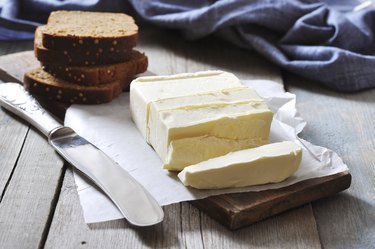
Olive oil and butter are both in the fats group, which the U.S. Department of Agriculture advises to consume "sparingly." One tablespoon of olive oil contains approximately 120 calories, while 1 tbsp. of butter contains about 100 calories. You may choose to consume these fats based on personal taste since the two do not differ much in calorie count. However, there are differences in the nutritional qualities between olive oil and butter.
Function
Video of the Day
Fats, or lipids, such as butter and olive oil, are essential macronutrients. Fats store energy, protect and insulate vital organs, serve as a precursor to certain hormones, maintain the integrity of cell membranes, and absorb the fat-soluble vitamins A, D, E and K.
Video of the Day
Distinctions
Although olive oil and butter do not vary significantly in calorie count, research from the International Journal of Molecular Sciences shows that a Mediterranean diet, where almost all sources of added fat come from olive oil, has important preventive health benefits, such as reducing the risks for heart disease. Another important distinction is that olive oil, which is a plant-based food, has no cholesterol while butter does.
Significance
Since our bodies cannot produce fats like omega-3 and omega-6, it is essential to obtain these from dietary sources. The USDA recommends consuming fewer than 30 percent of your daily calories from fats. While some fats are found naturally in foods such as meat, avocados and dairy, olive oil and butter are considered sources of added fat.
Considerations
When planning a balanced diet, consider properties outside of calorie count alone. Fats have an added benefit of giving foods flavor and providing satiety to meals. If consumed within total calorie limits to maintain a healthy weight, diets have room for both olive oil and butter.
Identification
When comparing nutrition labels between olive oil and butter, it is important to consider facts outside of calorie count. Nutrition labels identify total fat content and specific numbers on saturated and trans fats, which have been linked to increased risks for heart disease. Some butter may come in reduced-fat versions. The USDA sets strict guidelines for nutritional claims, so check to see that the fat content of butter marked "light" is 50 percent or less than a comparison brand.